In
the sixty three years since making this photo and after literally thousands more
images on a dozen different cameras shot during travels wordwide, this is one
of the favorites. The reasons are not just the memory lane visions it conjures
up of peaceful days in the Somerset countryside but bundled with it is some great
local history - some extraordinary photographic history and that special knowledge
that it can never be repeated, The
old bridge is still standing or at least it was at the end of 2016 when I paid
homage with a visit. Many of the trees are if anything denser and are protected.
The figure on the bridge with a fishing line is David Cole who is now greyer and
still a close friend. TM 2017 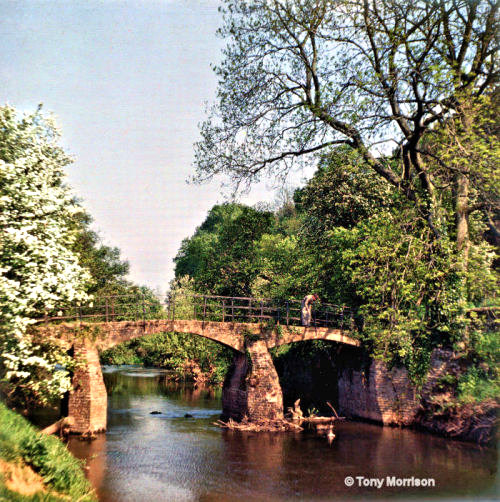
May
1954 - Netherclay Bridge across the River Tone near Taunton, Somerset on Dufaycolor
film The Baldix My
enduring fascination with photography began in January 1954 when I was still at
school with head down aiming for a university science place. After some persuasion
my parents gave me a folding Baldix camera…'it will help me with
my field-work…' nudge nudge '.... to record habitats, plants and people
on the spot' and
I needn't have said much more as my teacher was Ernest
Neal one of the leading naturalists of the day and also a wildlife photographer.
The Baldix was a good step up as for a couple of years had been I using two hand-me-down
simple cameras which I still rate as invaluable experience.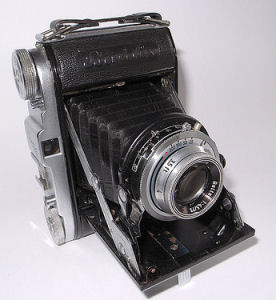
In the early 1950s such cameras as the Baldix and others made in West Germany
were in short supply due to import controls placed by the UK government to stem
the outflow of Pounds Sterling. The
country was recovering from World War ll.
Ernest
Neal who by then was famous for his photos and work with badgers used an expensive
British made Agiflex not subject to Sterling controls as even its lens was made
in England.
My
Baldix used '120 size ' film in rolls to take 12 pictures each 2 ¼ inches
square [6x 6 cms] and like the cameras was still in very restricted supply. Black
and white film was easier to get than colour film even if you could afford the
price. A roll of film for 12 pictures was the equivalent of about £15.00,
today [2017] Processing costs were extra. And remember the average wage was about
£5.00 per week.
A hobby
? = cash flow
In
those early days much of my photography was a hobby but one where my friends and
family paid for prints on photographic paper. School or village parties and new
clothes were especially good for the cash flow and soon I discovered that black
and white prints were a quick sell while colour was out of reach by price. But
anyway, I had to try colour. That was a 'must do experiment'.
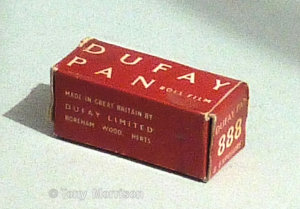 In
my home town of Taunton in Somerset we had several 'photographic chemists' where
by tradition they sold cameras, film and the chemicals for processing. I had shot
about five rolls of black and white on my new Baldix and 'Maunders' in the main
Street received a few rolls of Dufaycolor film at price much lower than their
other colour films such as Ferraniacolor - from Italy or Gevacolor -from Belgium.
There was no British equivalent in the 120 size apart from Dufaycolor made by
Dufay a company based in Hertfordshire 16 kms northeast from central London. In
my home town of Taunton in Somerset we had several 'photographic chemists' where
by tradition they sold cameras, film and the chemicals for processing. I had shot
about five rolls of black and white on my new Baldix and 'Maunders' in the main
Street received a few rolls of Dufaycolor film at price much lower than their
other colour films such as Ferraniacolor - from Italy or Gevacolor -from Belgium.
There was no British equivalent in the 120 size apart from Dufaycolor made by
Dufay a company based in Hertfordshire 16 kms northeast from central London.
I
did not keep the Dufaycolor packaging but I do have an old roll of Dufay Pan film
dated for use before 1956. The company address is Boreham Wood Herts. Pan film
was a black and white film but sensitive to all colours of light
Also,
and I did not realise it at the time the Dufaycolor in Maunders was the end of
the line. Dufaycolor production was suspended in 1956/57. Maunders also stocked
the chemicals I needed for home-processing the film. I cannot recall if I bought
a Dufay Developing 'kit' made by Johnsons of Hendon or the individual chemicals.
I feel it could have been just the chemicals as by then I was studying chemistry
as a school course.
So more about Dufaycolor.
Firstly,
here is the outline story and then follows the science bit which will be as a
non - geek précis. I promise. The web has plenty of deeper info. M
Louis Dufay I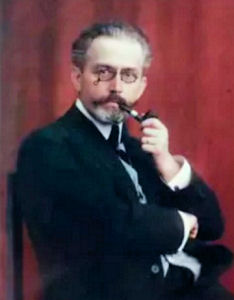 n
the annals of photography Dufaycolor goes back to 1908 when a French inventor
Louis Dufay began by photographically breaking down a scene into dot sized monochrome
replicas of the component colours - red, green and blue - almost, and I say that
cautiously, it was akin to the pixels in digital photography. Dufay named his
product Dioptichrome for the colour images on glass plates n
the annals of photography Dufaycolor goes back to 1908 when a French inventor
Louis Dufay began by photographically breaking down a scene into dot sized monochrome
replicas of the component colours - red, green and blue - almost, and I say that
cautiously, it was akin to the pixels in digital photography. Dufay named his
product Dioptichrome for the colour images on glass plates The
dots made by Dufay represented the colour of an object. The shade or tint of colour
and the amount of light falling on it was recreated by the combination of the
dots. The idea was not new and first attempts had been tried in the 1860s The
story of Louis Dufay is on Vimeo as a 52 minute film in French
La couleur et l'Heliophore Dufay
was preceded comercially and successfully in 1903 when two French brothers August
Marie Louis and Louis Jean Lumière produced their colour system later known
Autochrome Lumière.
The
main difference between the two systems was the method of breaking down the scenes
into the dot sized monochrome replicas of the colours. Autochrome was taken up
enthusiastically by the photographic community.
Autochrome
for amateurs and professionals lasted as a colour film until the 1930s when Kodak
in the USA and Agfa in Germany launched their own colour products based on a totally
different system. Up to that time the National Geographic Society with its now
famous 'Big Yellow Magazine' provided its photographers with Autochrome and there
are about 17,000 of their colour pictures in an extraordinary archive.
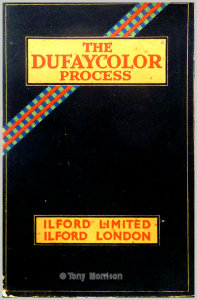 Meanwhile
Dufay's idea languished until in the 1920s when it was acquired by Spicers Ltd
a major British paper manufacturer who put R + D into the product and marketed
Dufaycolor as film for stills and movie cameras. But the revised product was never
a huge success in the face of the new film technology being introduced in the
1930s. Ilford, the British household name in photography of the era invested in
the Dufay product only to drop it, and if you want to follow the business story
there are several accounts on the web. SEE Graces guide Dufay-Chromex Meanwhile
Dufay's idea languished until in the 1920s when it was acquired by Spicers Ltd
a major British paper manufacturer who put R + D into the product and marketed
Dufaycolor as film for stills and movie cameras. But the revised product was never
a huge success in the face of the new film technology being introduced in the
1930s. Ilford, the British household name in photography of the era invested in
the Dufay product only to drop it, and if you want to follow the business story
there are several accounts on the web. SEE Graces guide Dufay-Chromex
An
aside - Dufay-Chromex
had offices in Cockspur Street, London close to Trafalgar Square. The building
is still known as the P & O Building and it was from there that many of passengers
bought tickets for their ill fated journey on the RMS Titanic [1912] The
booklet on the right dates from the Ilford era and contains a brief history of
the product and its revival with better technology.
My interest in Dufaycolor began when as a student I saw some end-of the line
stock in 'Maunders' a local chemist shop at a price I could just about afford.
So now, how did the film reproduce colour?
Dufaycolour
and its predecessor Autochrome were black and white films very craftily adapted
to replicate colours.
Film
as we knew it and as still exists, consists of a transparent base such as strong
semi-rigid plastic with a light sensitive emulsion coating one side. The early
coatings were made of egg albumen or gelatine sensitised with silver compounds.
Collodion a product of nitro cellulose aka guncotton an explosive dissolved
in ether was also used -'sounds a dodgy snap shooter to me.
Developing
and fixing
In
a camera such as my Baldix light falls on the film's emulsion and causes changes
to the silver that can be enhanced by using solutions of chemicals generally known
as 'developers'.
The
changes can be retained permanently by using other chemicals - the 'fixers'. The
result is a negative image --- dark where light has fallen and paler for areas
recording, say a shadow or black hat. 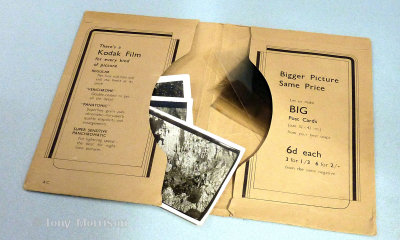 To
make the prints for a family album, sensitive paper was exposed to light passing
through a film negative. Light or pale areas in the negative formed darker areas
on the print. OK So far? To
make the prints for a family album, sensitive paper was exposed to light passing
through a film negative. Light or pale areas in the negative formed darker areas
on the print. OK So far?
If
you have an old family album there's a good chance that some of the original film
will be somewhere and you can compare the negative and the print… the 'positive'.
Chemist shops often provided the processing service and prints and their negatives
were returned in wallet-like envelopes. Specialist laboratories still exist for
developing film and making traditional prints - Ilford is still working - check
the web [2017]
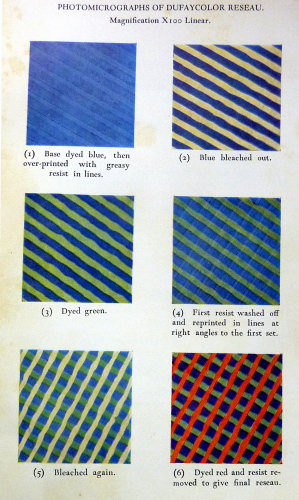 Now
the tricky bit. Now
the tricky bit.
Dufayclor
and Autocrome coated one side of their film base with a pattern of colours. Autochrome
used a random scattering of coloured grains of potato starch and Dufay a printed
pattern of coloured lines or réseau - this is the stuff of the early inventors.
By the time Dufaycolor was being made commercially the lines of the réseau
were being printed on the film base 20 to each millimetre. A thin varnish over
the réseau assured its permanency. The
layers The images are from
the Ilford -Dufaycolor booklet. On the right are the stages to build up the final
pattern - bottom right. And below a section through the final film. Both
are highly magnified and in the final pattern [bottom right] there are about 1.5
million dots in a square inch
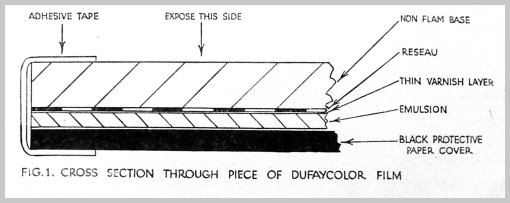
A
light sensitive layer of emulsion was then coated over of the coloured réseau
and here I should add that all the layers were dry and very thin. A thin layer
of varnish was added to protect the réseau. Autochrome was similar except
coloured potato starch grains were used instead of the mechanicllly printed réseau Now
the final mind bender
Unlike
normal black and white photography where the light from the camera lens falls
directly on the sensitive emulsion , with Dufaycolor [and Autochrome] the light
from the lens had to pass through the transparent film base and réseau
The colours to reaching the sensitive layer were recorded with a density of light
and shade proportionally. A 'latent' image was created in the sensitised emulsion
ready to be processed. So
what next? The
films could be developed normally in chemical solutions to obtain a black and
white negative image and by simple wizardry with more chemicals they were changed
to a positive image. Don't glaze over as the next part is the fun bit.
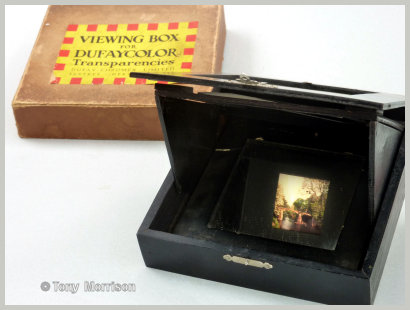 The
final stage of the process was to 'fix' all the changes, dry the film and view
the picture against a bright light. And…… Hey Presto ! A colour picture. The
final stage of the process was to 'fix' all the changes, dry the film and view
the picture against a bright light. And…… Hey Presto ! A colour picture.
The images were
not brilliantly coloured as we are accustomed to seeing today. A picture by this
method was in effect a black and white image with its light, shade and gradations
of colour being viewed through the film base and a screen of coloured starch grains
or Dufay's réseau. But it worked - and that was invented over 100 years
ago.
In the
1930s Ilford and Dufay marketed a special viewer to show the images in sunlight
and with a filter for indoor light - in those years usually a reddish incandescent
electric lamp.
Three
versions were made and the one on the right is mostly of thin ply-wood painted
with matte -black paint. It could have been made in a 'shed workshop'
Enter
David Cole
David, a school friend lived a few houses down the road and was similarly fascinated
by photography. My excursion into colour in an age of black and white plus the
challenge of home processing drew David to the rear door of my parent's home at
5 AM one early summer morning. The days were warm and with ice from a fridge our
only way to work at a controlled temperature of 65° F [ 18.3 °C was in
the stone floored kitchen using water we had left in buckets outside to cool overnight.
The
chemicals in solutions had been made the night before and also were kept outside.
The Dufaycolor film I had shot on the Baldix was pre-loaded in a lightproof processing
tank.
Apart
from an array of chemicals - none of which was seriously dangerous - maybe the
sulphuric acid was the worst, the developing process was fairly straightforward
with about 10 steps.
We
anticipated only one critical moment when we were to expose the entire film to
a 100 watt light for four minutes at a distance of about three feet or just under
one metre. After that exposure it was possible to complete the processing in subdued
light.
So
with David checking the timing and passing the solutions we reached the 'exposure
to light' stage and all seemed to be going well until without any warning the
sensitive emulsion began to peel away …. It simply slipped off the base as
a blob of black gloop. Yuck … and schoolboy expletives. Our efforts and the
developed images went into a bucket as slop.
All
was not lost
 But
all was not lost as a small section of the film remained intact and we salvaged
four shots. One - the Netherclay Bridge is a favourite even after my sixty years
of photography worldwide. The bridge is still standing and the foliage is a grand
as ever. But
all was not lost as a small section of the film remained intact and we salvaged
four shots. One - the Netherclay Bridge is a favourite even after my sixty years
of photography worldwide. The bridge is still standing and the foliage is a grand
as ever.
Here
is the résau with the sky and trees 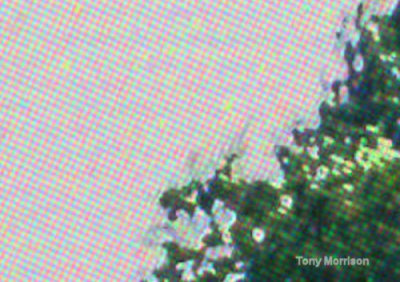
That's
David on the bridge with a fishing rod - his hair is a youthful reddish and now
grey he's still taking pictures with his collection of Leica cameras [2017]. Back
in 1954 David had a Dacora which, like my Baldix was made in West Germany - memory
lane stuff indeed. And
the other survivors on the roll of film. 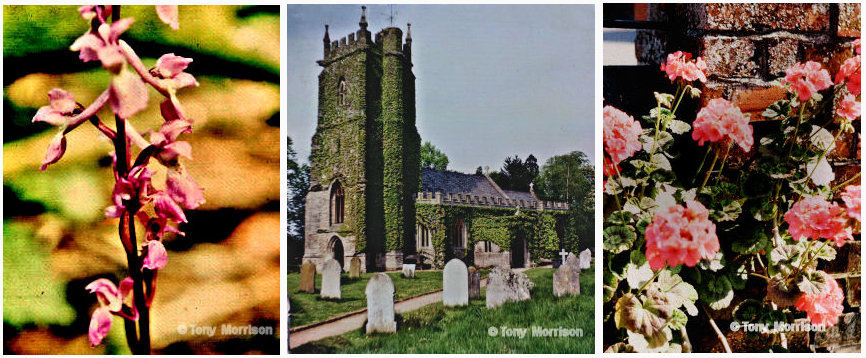
Left
- An Early Purple Orchid
- Orchis maculata In 1954 I was coming up to my final year studying biology
at school and being taught by Ernest Neal one of the great names in ecology of
the 1950s. Neal was a passionate photographer who urged me to record as much natural
history as I could Centre
- The 13th C church of St.Giles at Bradford-on-Tone about 5 kms from the village
where I lived . In this picture of the tower is covered with ivy, a climbing plant.
Today the stonework is clean Right
- Geraniums and an old brick wall in Taunton. One of the recommendations of Dufaycolor
was to choose colourful, bold subjects. Here the sun and contrast was just too
severe. I cannot
remember the subjects for the eight that went into the bucket and can only guess
they were plants or scenes near our village. 'Pity.... A
line in the 'troubleshooting' page of a Dufay technical booklet suggests it may
have been too strong [concentated] bleach 'bath' or too long in the solution
or a difference in temperatures between each bath But from the Dufay experience
I moved on to the newer systems of Ferraniacolor, Gevacolour, Anscochrome for
transparencies [slides] and Kodacolour and Agfacolor for prints. It
was not until the Bristol University Trans-Continental Expedition [see on this
site] that I used Kodachrome almost exclusively with a few rolls of Kodak Ektachrome.
Kodachrome was an invention of the mid 1930s and lasted until 2005 - it proved
to have colours that lasted longest without fading. But
that is another story. Meanwhile Happy Snapping... from a 1930s film wallet 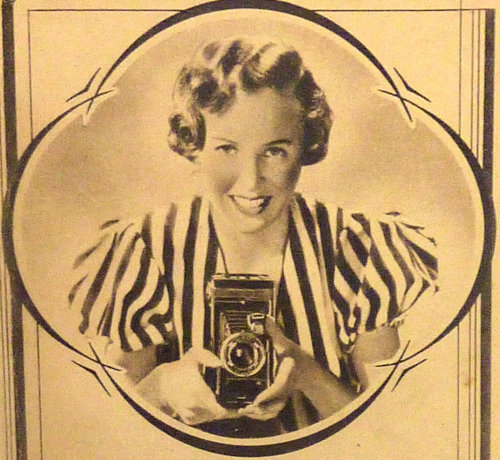
With
thanks to David Cole now working as David Elkington-Cole,. Evelyn Whitfield for
the careful scannng of the originals and David Truzzi-Franconi for his valuable
input concerning the 1930s font used by Dufay-Chromex
|